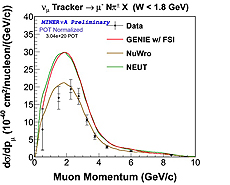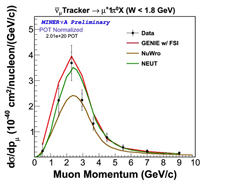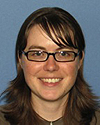Seeing two sides of the same coin
 |
| This plot and the one below show the differential cross sections (or likelihood per proton or neutron) for a neutrino to make one or more pions and a muon with respect to the muon momentum, with a few different models used by neutrino oscillation experiments. This plot is for events in which charged pions are made by neutrinos. The plot below is for events in which neutral pions are made by antineutrinos. The two different models represent turning on and off the effects of the nucleus where the neutrino interacted. The data clearly represent the effects of the nucleus being "turned on," and the two different predictions have the same shape. The inner error bars are statistical and the outer error bars are the total uncertainties. |
Para una versión en español, haga clic aquí. Para a versão em português, clique aqui. Pour une version en français, cliquez ici.
It can be hard to detect the ghostly neutrino, which rarely interacts with matter. To overcome this, neutrino experiments use detectors made of neutrons and protons bound up in heavy nuclei. The way these nuclei affect the particles made by neutrino interactions is not well understood, so MINERvA is working to measure this in as many ways as possible.
Sometimes a neutrino creates a quark-antiquark pair called a pion, and the neutrino itself can change into a charged particle called a muon (an antineutrino can create an antimuon). The pions often interact with the nucleus where they were made, changing their charge or even stopping before they can leave. On the other hand, the muons or antimuons are not affected by the nucleus at all, according to predictions. So one way to measure the effects of the nucleus is to take the same interaction and look at it from both sides: from the pion side and from the muon side.
MINERvA presented results about the pion side neutrino measurements and the antineutrino measurements. At today's Joint Experimental-Theoretical Physics Seminar, the MINERvA collaboration will show new information about the muons that are made along with the pions in these interactions and provide a more complete picture of the interaction.
There are models that try to describe this process. Neutrino experiments, especially those that try to measure how neutrinos change over time, need those models to get both the muon side and the pion side right: It's not enough to describe only one kind of particle. Creating these models has been a challenge due to the complicated nature of the nucleus. In addition, there are disagreements between these models and the experimental data taken by many neutrino experiments. To make matters even more confusing, sometimes different measurements of this process at different energies (or on different nuclei) don't all agree with the same model.
By studying the muons as well as the energies of the pions, we can compare between the different models of the nucleus and their effects on the interaction. Eventually there will be at least one model that can describe all the data. This will give us a better picture of the nucleus, which ultimately improves our ability to measure the neutrino.
—Aaron Bercellie, University of Rochester
 |
| This plot shows the cross sections described in the top figure caption with several models. The cross sections here are shown for antineutrinos and neutral pions (instead of for neutrinos and charged pions as in the top figure). |
 |
| Carrie McGivern of the University of Pittsburgh worked on this analysis and will present the results and more at the Joint Experimental-Theoretical Seminar today. |
|